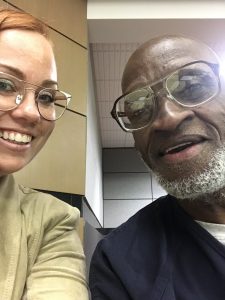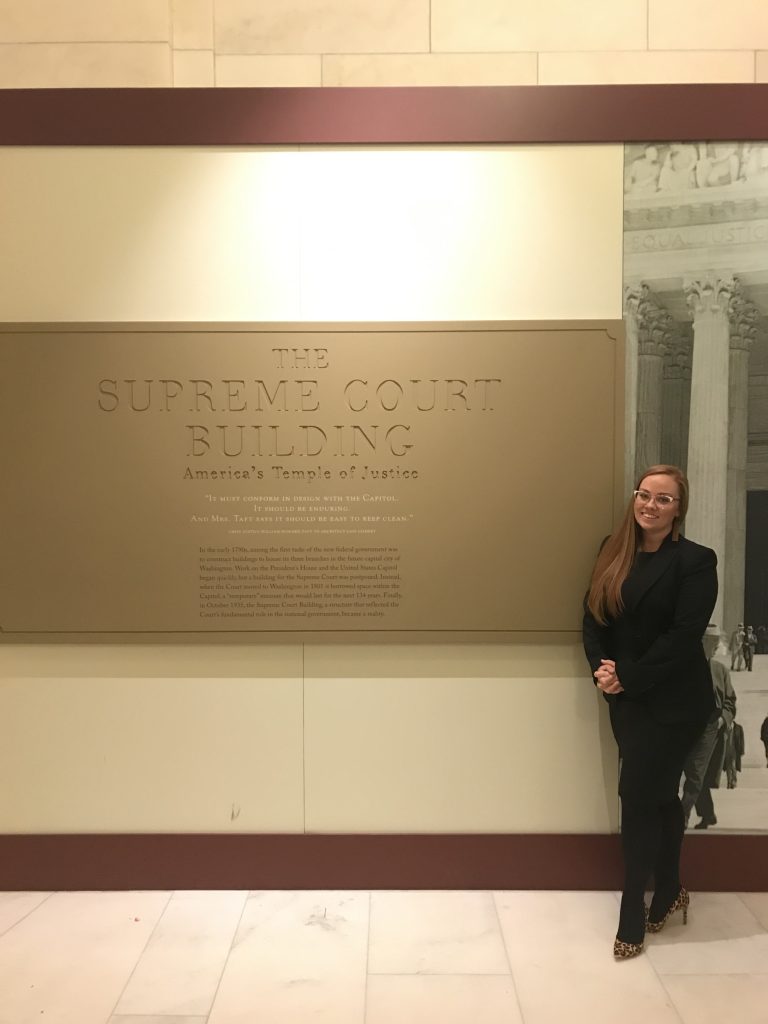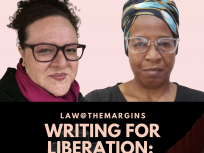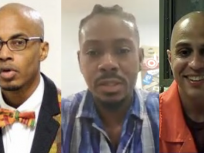In May 2019, I had the honor of representing a dear client, Amiyn Haliburton (chosen name), at a hearing challenging his death sentence as unconstitutional because he is intellectually disabled. Next to him, rubbing his back as he processed the overwhelming emotions of seeing family, some for the first time in nearly 40 years and others for the first time ever, I sat at the table churning over the steps that led me to that very moment.

I graduated from law school in 2009, ten years ago. I was 24 and more eager than ever to take on the world. I am the first of my family to graduate from a traditional college, the first to attend graduate school, the first with letters behind her name, and I am also the first with crippling debt. What an odd contradiction – here I was a class jumper, yet I navigated the world with the weight of a mortgage in the form of student loans sitting on my shoulders. Nonetheless, I was undeterred.
When I entered law school, I wasn’t quite sure about what being a lawyer really meant. Outside the television portrayal of trial lawyers, I had no idea what the day-to-day was like for an attorney nor did I have any clue where I would find inspiration and fulfillment. Sure I wanted to make change, I had become quite the activist as a sociology undergraduate student; but at the time, I thought success meant “Big Law.” Candidly, as a law student, I already felt like an outsider. Life at a firm was an even more foreign concept. It took a lot of inner reflection to understand what being a lawyer meant to me, and it just didn’t include mergers, acquisitions, contracts, and board meetings. Although I fought it every step of the way, my background and life experience had set me up for a life as a Defender.
Becoming a Public Defender
I was no stranger to the problems plaguing our (in)justice system, and understood all too well the obstacles of poverty, mental health issues, addiction, and incarceration. My parents divorced after a tumultuous thirteen-year marriage, and my brother and I were raised by my father. We grew up in a working class neighborhood, and our father did his best to keep a roof over our heads, food on the table, and my brother and I safe and out of trouble. Our mother remained in our lives; however, the relationship was difficult. She suffers from bipolar disorder and major depression disorder, which unfortunately led to substance abuse and incarceration. Thankfully, my mother has since survived her long and arduous battle with addiction, but not before she lost many years and relationships. For many years, I was resistant to the idea that those experiences (and many others) made me a better advocate, and I found myself trying to hide my experiences, which seemed to diverge drastically from those of my classmates. The more I uncovered what lawyering really meant, the less I could hide my connection to public defense and social justice.
Although I fought it every step of the way, my background and life experience had set me up for a life as a Defender.
I was offered my first job the second day of the bar exam, making it one of the most fulfilling days of my life. With full-on tears of pride and accomplishment streaming down my face, I left the exam feeling like I was on top of the world. I’ve clearly never run for or won the presidency, but I’d like to think surviving the bar exam feels just as incredible and fulfilling. Completely engulfed in my emotions, and certain the moment couldn’t be more perfect, the public defender’s office called to offer me a Juvenile Defender position. Bursting at the seams with pure joy, for the first time ever, I felt like I was exactly where I needed to be.
Although I was thrilled beyond words, at the time I had no idea that being a Juvenile Defender would be the greatest job on the planet. For five years, I stood next to the most hilarious, kind, thoughtful and loving folks I’d met to date – my juvenile clients. Not only did they help me become a more effective advocate, they helped me learn how to repurpose my own trauma for good both in court and in my daily life. Representing kids can be in itself quite the conundrum – a public defender isn’t meant to play the role of a parent or make decisions for the best interests of the child. The client is the child, and they drive the outcome. It sounds straightforward, but remember, children aren’t usually equipped to make the decisions imposed by courts and aren’t often in control of the outside influences that led to court contact in the first place. And even more difficult to balance, the parents or guardians often have their own opinions. My practice required creative strategies I didn’t learn in classes or in training. I engaged with parents and community resources, and I learned to use my story as a means to encourage courts to resist applying unrealistic standards on the kids. The practice of developing complete and meaningful narratives of my client and their circumstances taught me greater compassion for my clients as well as my own family. My narrative carried me – my story made me stand taller and stronger for my clients and myself.
Transitioning to Capital Defense
I left juvenile defense to spend five years standing next to guys like Amiyn Haliburton, sentenced to die at the hands of the State of Florida. This picture was taken during Amiyn’s first time off of death row and back in court in 20 years. It was the first time he saw much of his family in as many years, and for some, it’s been much longer. This is also the first time Amiyn has ever taken a selfie – he has lived in a small cell away from such technology for nearly four decades. I can’t explain the warmth I felt watching Amiyn take it all in and feel connected. This was a little win.
My narrative carried me – my story made me stand taller and stronger for my clients and myself.
Mr. Haliburton was sentenced to death in 1983 for a 1981 murder. On direct appeal, the Florida Supreme Court reversed his conviction because the State used a statement of Mr. Haliburton’s obtained in violation of his Fifth Amendment rights. On retrial, Mr. Haliburton was again convicted. The jury returned a recommendation for death by a vote of 9-3, and the court again sentenced Mr. Haliburton to death. His case became final in 1991.
Following the U.S. Supreme Court’s 2002 decision in Atkins v. Virginia, prohibiting the execution of intellectually disabled persons, Mr. Haliburton challenged his own death sentence because he is intellectually disabled. After several years of litigation, the State court denied Mr. Haliburton’s claim. In 2014, Mr. Haliburton filed a writ of certiorari to the United States Supreme Court. Three months later, the U.S. Supreme Court in Hall v. Florida held that Florida had been misapplying the science used in determining whether someone is intellectually disabled. The U.S. Supreme Court granted certiorari and remanded Mr. Haliburton’s case to the State court for an evidentiary hearing on his intellectual disability claim. Nearly fifteen years after he first filed a motion challenging his sentence pursuant to Atkins, the state court held Mr. Haliburton’s evidentiary hearing in May. This work has taught me patience and resilience.
“Winning” in the Criminal Defense System
My career has been full of ups and downs, powerful wins and devastating losses, but it’s all been worth it for smiles like Amiyn’s and the hugs of so many others. The wins have come in various forms, they aren’t always a “not guilty,” but each win has had its own significance. One of the most impactful was overturning a child’s sentence, which included a requirement that he register with the sex offender registry board for the rest of his life, a sentence which would have marred this child’s life before it had even really begun. However, I’d be remiss if I didn’t mention that it’s the losses that really stick with you. The first of many times I had to fight back tears in court occurred not long after I became a public defender. A juvenile client was incarcerated for violating a house arrest order. My client was sixteen and a new mom. At the time, she lived with her mother, who was secretly attempting to gain custody of her one-week old son. Thinking her probation officer would help, my client left her home and went to court. Unfortunately, her mother used this against her and contacted probation to report that she left the home, and therefore, violated house arrest. By the time my client arrived at the courthouse, the court had already issued a warrant for her arrest. The walk was no more than a mile. The judge refused to hear my client’s story and instead found the violation, sending the 16-year-old to lock-up and separating her from her one week-old son. Upon learning of the injustice, the Chief Justice of the juvenile court vacated the finding and released my client. However, the Department of Children and Families had already become involved. My client spent the next 18 months fighting to get both herself and her son out of the system.
One of my most devastating of losses happened outside the courtroom. I’d been working with a juvenile client for several years on several minor cases. However, because my client lived in a county with the highest pretrial detention rates, even the smallest of infractions often led to incarceration. In juvenile court, this translates to frequent court hearings, family meetings, and trips to lock-up. Over the course of my representation, I’d become quite close to both the client and his mother, spending many afternoons in their living room and kitchen, and many weekends with the client at the pretrial detention facility during brief periods of incarceration between court dates. I also lived in the community I worked, and often saw him and his mother outside of work. This particular client was a great kid, with incredible potential, he was smart and a talented athlete. He was charming and funny. Overtime he opened up and shared many of the struggles he battled that led him to court.
Life advocating for folks on death row is slower and much more emotional. Sometimes I’m not in court for months at a time, and there aren’t as many of the little wins. Because my clients are already convicted and on death row, the presumption of innocence is long gone.
My client was a teenager just trying to be a kid, and his mother was doing the best she could to raise three boys in an overly policed neighborhood. She looked to me to help her son navigate a world that was stacked against him, both on the street and in court. Ultimately, we resolved his cases in the most favorable way possible – he was able to remain in the community. He continued attending school and staying out of trouble. Even after his case ended, we all kept in contact. I continued to see the family in the community and check-in on him and his mom. He also continued to cause me unnecessary worry when he popped up unexpectedly in the courthouse time and time again, but it was usually to support friends, family and check-in with probation. His greetings consisted of a loud “Miss Bri!” that echoed the large open courthouse, followed by the warmest hugs and brightest smiles.
While in court one Tuesday morning, preparing for arraignments, I received an unexpected call from my boss. I stepped out to the hallway and answered, her usual joyful “hello” was replaced with a solemn “I’m so sorry.” She could barely get out the words, my client had been attacked at a party two nights before, and he passed away that night. He was 18. The hustle and bustle of the hallway fell silent, my heart sank. If the news couldn’t have gotten any worse, I learned another of my client’s had been involved in the attack. Although we weren’t quite as close, I had spent a great deal of time with him and established a relationship. He had just become a father. He was recently released from detention and starting over. He, too, had so much potential and a bright future ahead. His fresh start ended before it began, he was now facing manslaughter charges. I couldn’t believe it. I was a mess. Two of my clients had lost their lives.
My Life as a Capital Defender
The work I do now as a capital defender, representing adults in their death penalty postconviction and habeas proceedings, is fulfilling in a different way – I’m not in court every day, seeing the little wins. And I can’t overstate how much the little wins kept me going. I might have lost a tough probation revocation hearing as I mentioned above, but maybe that day or the next I’d get a case dismissed that opened up the doors for a client to follow a career dream he couldn’t have followed with a record. The greatest of wins is the overall success I had advocating for youth as a whole. In my five years as a public defender, not one of my clients was ever indicted as an adult. Pretrial advocacy and the development of mitigation were the most effective tools in making sure the court saw my clients as the kids they were.

Life advocating for folks on death row is slower and much more emotional. Sometimes I’m not in court for months at a time, and there aren’t as many of the little wins. Because my clients are already convicted and on death row, the presumption of innocence is long gone. Now, it’s my job to prove that my clients deserve another trial, another penalty phase, or are actually innocent. The cases take years of investigation and appeals, and during that time, my clients remain alone in their cells for 23 hours a day. Often, we lose because overturning a death sentence is political. It’s why moments like the one with Amiyn hold a significant space in my heart. I can tell the stories of my guys, but I’ve never been able to take a picture or capture the moment like this. Amiyn is still on death row, but we continue to fight daily, and his trip to court was full of many beautiful experiences to keep him going. Aside from the other stuff that isn’t as fun (litigation can take an emotional and mental toll), these last ten years have been incredible. I am the luckiest.




